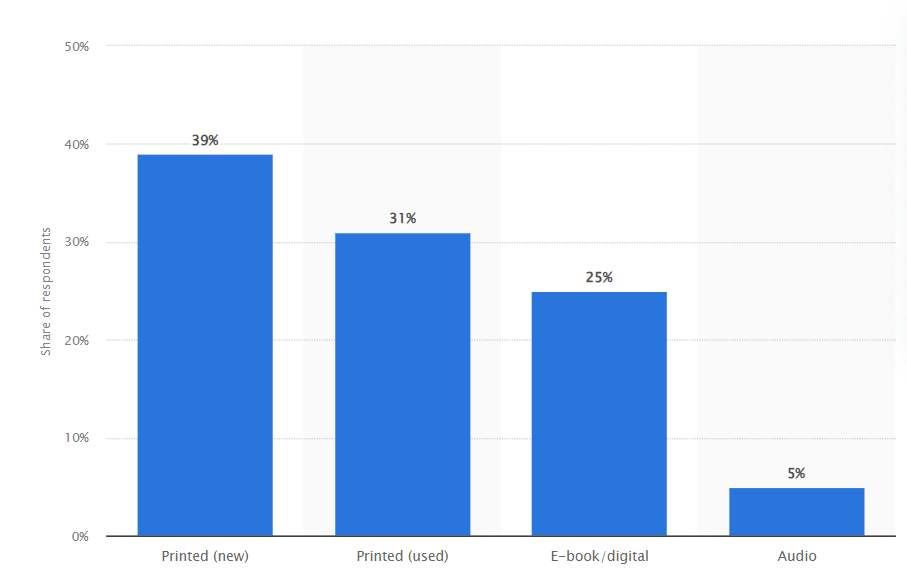How Many Books Are Published Each Year? [2024 Statistics]
Posted by Rob Errera on 08/18/2023
![How Many Books Are Published Each Year? [2023 Statistics]](https://cdn11.bigcommerce.com/s-dnybxc6/images/stencil/750x500/uploaded_images/how-many-books-are-published-each-year.jpg?t=1645137167)
At a Glance: Annual Book Publishing
- Each year, 500,000 to 1 million new books come out.
- Including self-published authors, the count reaches close to 4 million new book titles each year.
- In 2021, there were about 2.3 million new self-published books in the US, marking a decline compared to the preceding two years.
- Children's Publishing remains a popular and thriving sector, with a projected growth towards a $11.1 billion market value by 2027, up from $9.086 billion in 2020.
- In the US alone, the Children's Book Publishing industry achieved a market size of $3.3 billion in 2022.
- Audiobooks are on the rise too, generating about $5.4 billion in 2022, with the US contributing $1.8 billion. This showcases evolving reading habits.
So, how many books are published every year?
The answer is more complicated than you’d think. Figures range from 500,000 to one million books published annually.
However, if you include self-published authors you’re looking at close to 4 million new book titles published each year.

With close to 4 million new titles published each year, keeping library shelves stocked with the most current information is a challenge for students and librarians alike.
So Many Books, but Not All Get Printed
That’s a lot of books, even for avid readers (check out the latest book and reading statistics). But bear in mind, not all published books make it into printed form.
The majority of self-published titles are print-on-demand, meaning paper, ink, and glue are only used to bind a physical book together when one is ordered.
This differs from traditional book publishers who often print thousands of copies of books in advance.

A traditional printing plant requires a big space, a lot of resources, and generates tons of waste.
So Many Books, So Little Sales
Even though there are a lot of authors publishing books, most authors don’t sell many. The typical self-published author sells about five copies of his book.
The average US book now sells less than 200 copies per year and less than 1000 copies over its lifetime.
According to a study conducted by Google Books, there have been 129,864,880 books published since the invention of Gutenberg's printing press in 1440.
There's a catch, however. Google Books doesn't factor in books published after 2010, nor does it include self-published book titles. Digital publishing has risen 246% since 2010, according to Bowker.
That means a lot more books have been published that are not being accounted for.
Books by the Numbers
Print is still an essential part of book publishing, with people still gravitating toward print editions of books rather than digital editions.
According to Publisher’s Weekly, Bookscan, which does include Amazon sales, reports 789 million print books were sold in 2022 in the US.
- A 2020 survey from Statista shows that print is still the most popular book format in the United States with 70% of people surveyed preferring print to e-books or audiobook. Out of those, 39% like to read new books.
- 826 million physical books were sold in 2021 the US, a growth of 8.9% over the prior year. Trade paperbacks sold 450,000 print units.
- In 2022, revenue for book sales in the United States generated $9.1 billion, compared to $8.6 billion in 2020. Hardcover books accounted for nearly $3.2 billion of those sales.
Preferred Book Formats Among US Adults (April 2020)

How Many Books Are Self-Published?
In the US, there were around 2.3 million new self-published books in 2021, a decrease from two previous years (over 1.6 million in 2018).
But, as stated above, not all self-published authors use trackable ISBNs so that number may be higher.
But many self-published titles are print-on-demand, meaning that physical copies of the book are not printed until a customer orders one. That greatly reduces the physical resources needed to publish a book.
No paper, no glue, no printing or binding. Most self-published books exist in a purely digital format until physical copies are ordered.
And, since most self-published books only sell a handful of copies, they don’t use up physical resources the same as traditional publishers, who will print “bulk runs” of books in batches of 1,000 copies, 10,000 copies, 100,000 copies, or more.

A modern print-on-demand printing press benefits both the consumer and the environment.
How Many E-Books Are Published Each Year?
Research indicates that 191 million eBooks were sold in the US in 2020, generating $1.1 billion in sales in 2020, up from $983 million in 2019.
It’s important to understand that Amazon — arguably the biggest seller of eBooks — was not included in Statista’s latest figures, so the true size of the eBook market is likely much larger than reported. Amazon is the biggest marketplace for e-books followed by the Apple e-book store.
E-books are still a strong market and publishing revenue could reach $7 billion by 2025.
Books for Specialty Markets
Industry Research reports the global Children's Publishing market is expected to grow and be worth $11.1 billion by 2027, a significant rise from its value of $9.086 billion in 2020. In 2022, the Children's Book Publishing industry in the United States had a market size of $3.3 billion.
The major of children's books are physically printed and, since they often use thick paperboard pages and vibrant inks, they often require more raw materials to produce. But who doesn't love Eric Carle's board books?
In addition to children's books, other areas of publishing that rely heavily on printed and bound books are education/textbooks, science and medical journals, and law reviews.
These specialty publications are mainstays of traditional publishing that will keep old-school printing presses and book binderies in business for many years to come.
Don’t Forget Audiobooks!
Book purists argue that audiobooks aren’t reading, they’re listening.
Regardless audiobooks are the fastest growing area of publishing.
According to the latest report by Grand View Research, audiobooks generated around $5.4 billion in 2022. The audiobooks market was primarily led by the North American region, contributing the largest share of revenue at over 45%.
Audiobooks Market Trends, by Region in 2022

People like the portability of audiobooks, as well as the ease of consumption — who doesn’t enjoy listening to a good story?
In the United States, audiobook sales amounted to $1.8 billion in 2022, compared to about $1 billion in 2018. Nearly half of all Americans have listened to an audiobook at some point and 23% listen regularly, according to Statista.
There were 71,000 audiobooks published in 2020. This is an 8.5% increase over 2019’s 60,303 published audiobooks, and a whopping 23% increase over the 16,309 audiobooks published a decade ago.
The best-selling audiobooks tend to reflect the best-selling list of print and eBooks. Two of the biggest sellers are James Clear's “Atomic Habits” and Ann Patt-chett's “Tom Lake.”

E-readers are inexpensive and can hold thousands of low-cost books, but readers are still drawn to traditional print editions.
Book Publishing Gets Greener
The New York Times estimates that print books use three times more raw materials and 78 times more water to produce compared to eBooks.
The rise of e-books, print-on-demand technology, and more efficient digital printers have helped reduce waste in the publishing industry. Massive print runs of books and periodicals created —literally — tons of waste.
According to author Dean Wesley Smith, it was acceptable to have a return rate of 50% or more for traditional printed books during the 1990s.
That means more than half of the books printed during that time were returned to publishers and destroyed.
According to Publisher’s Weekly, book return rates for traditional publishers have shrunk to between 20-25%, but it is still a colossal waste of resources.
Perhaps one of the greatest advancements in publishing is the new print-on-demand model, which puts an end to costly bulk print runs and the wasteful returns system.
In a virtual world, books no longer have a “ shelf life” where they are displayed in bookstores for 30 days then returned to publishers for recycling.
There’s no need for boxes for printed books to sit in warehouse storage. Now a published book can stay in print forever with no drawbacks to consumers or the environment.
That’s a good thing!
Further Reading:
- Printing Statistics: The Latest Global Data in CMYK
- 3D Printing Statistics (2023 Additive Manufacturing Data)
- Printing Industry Trends: What Do Stats Tell Us?
- Staggering E-Waste Facts & Statistics 2023
- Printer Shortage and Deficit of Toner, Ink and Paper: All You Need To Know
Statista
APA Report
IBIS Worlds
Publishers Weekly
https://www.bowker.com/siteassets/files/pdf-files/...
https://www.amazon.com/Best-Sellers-Audible-Books-...
https://www.deanwesleysmith.com/the-new-world-of-p...
https://www.industryresearch.biz/global-children-s...
https://www.grandviewresearch.com/industry-analysi...
https://archive.nytimes.com/www.nytimes.com/intera...
 Calculating arrival date
Calculating arrival date









